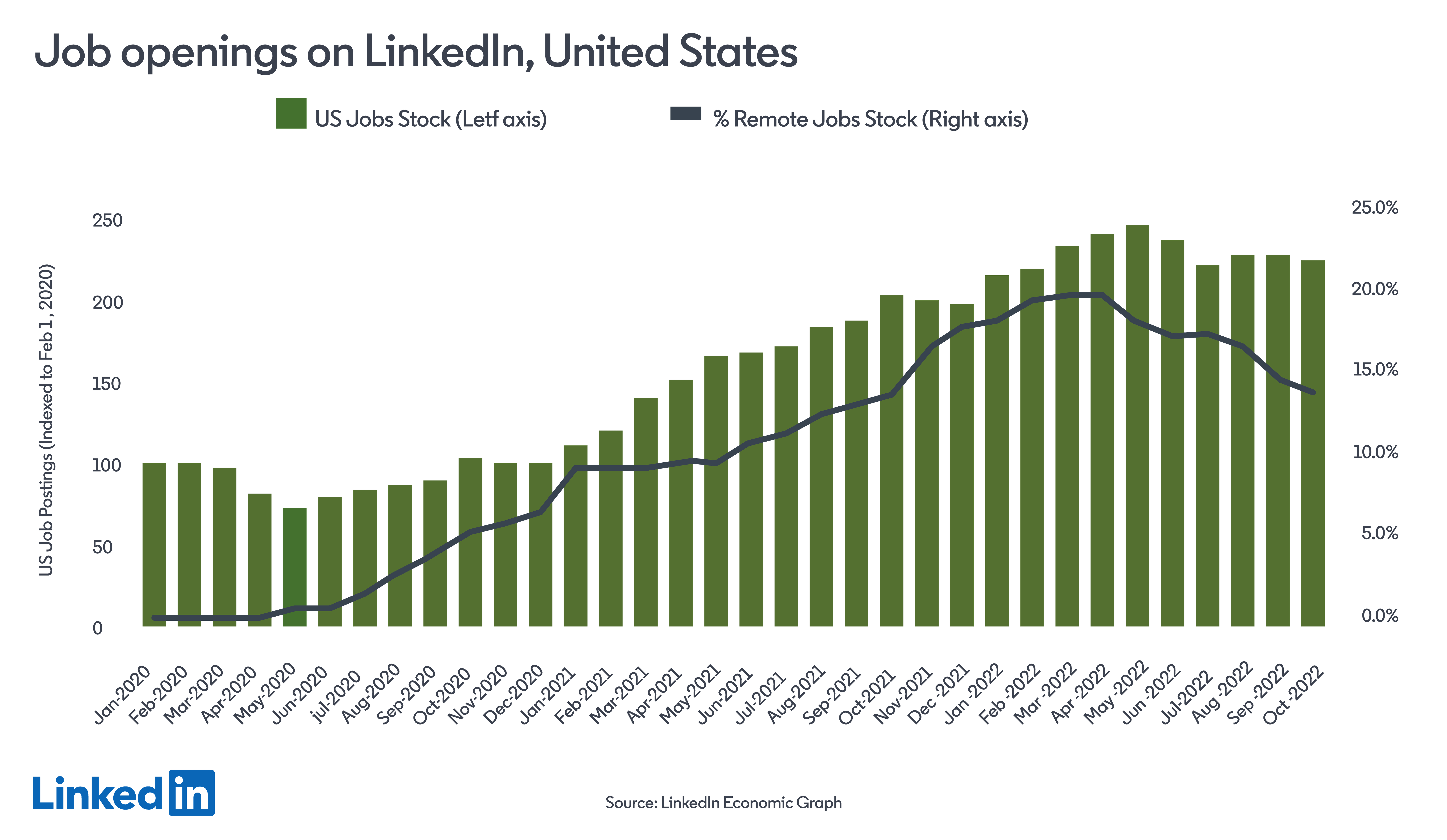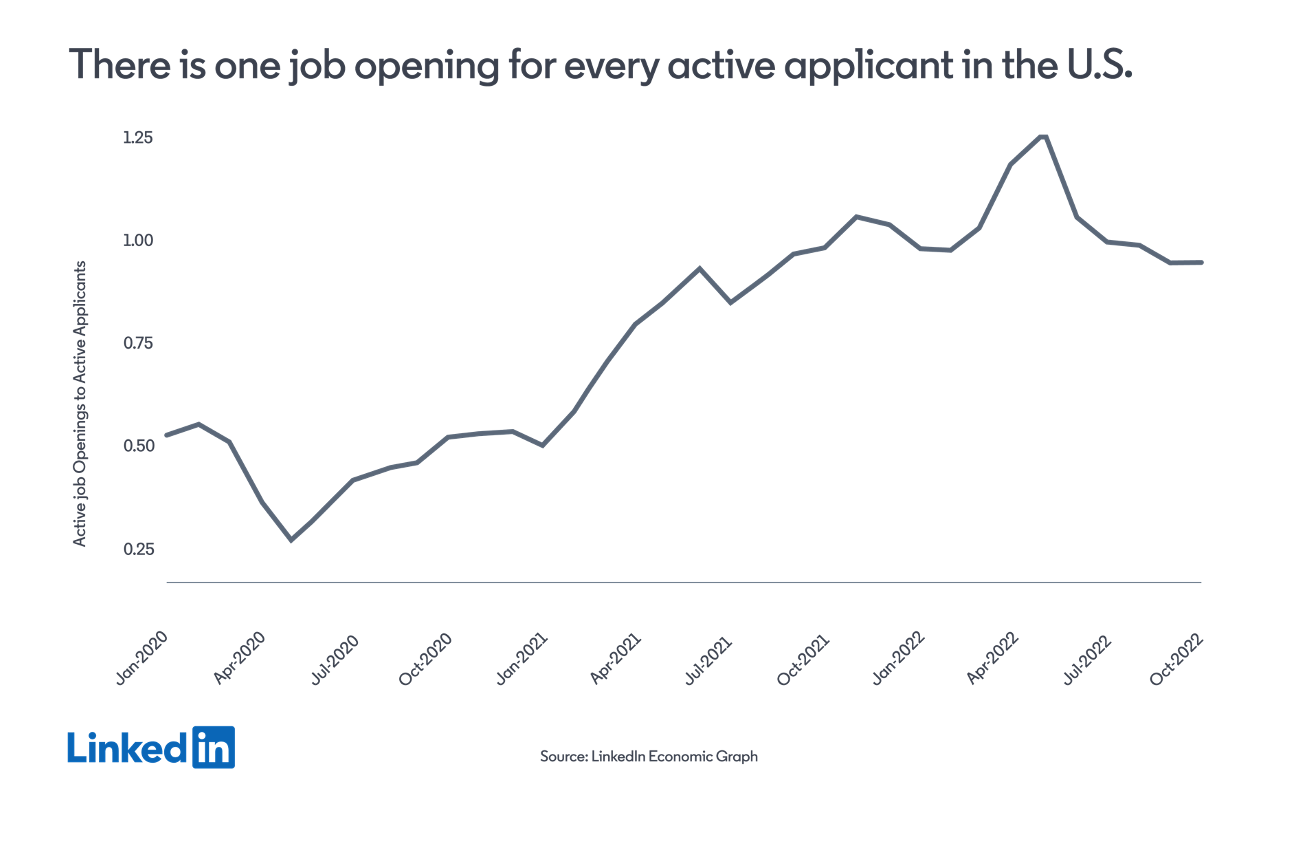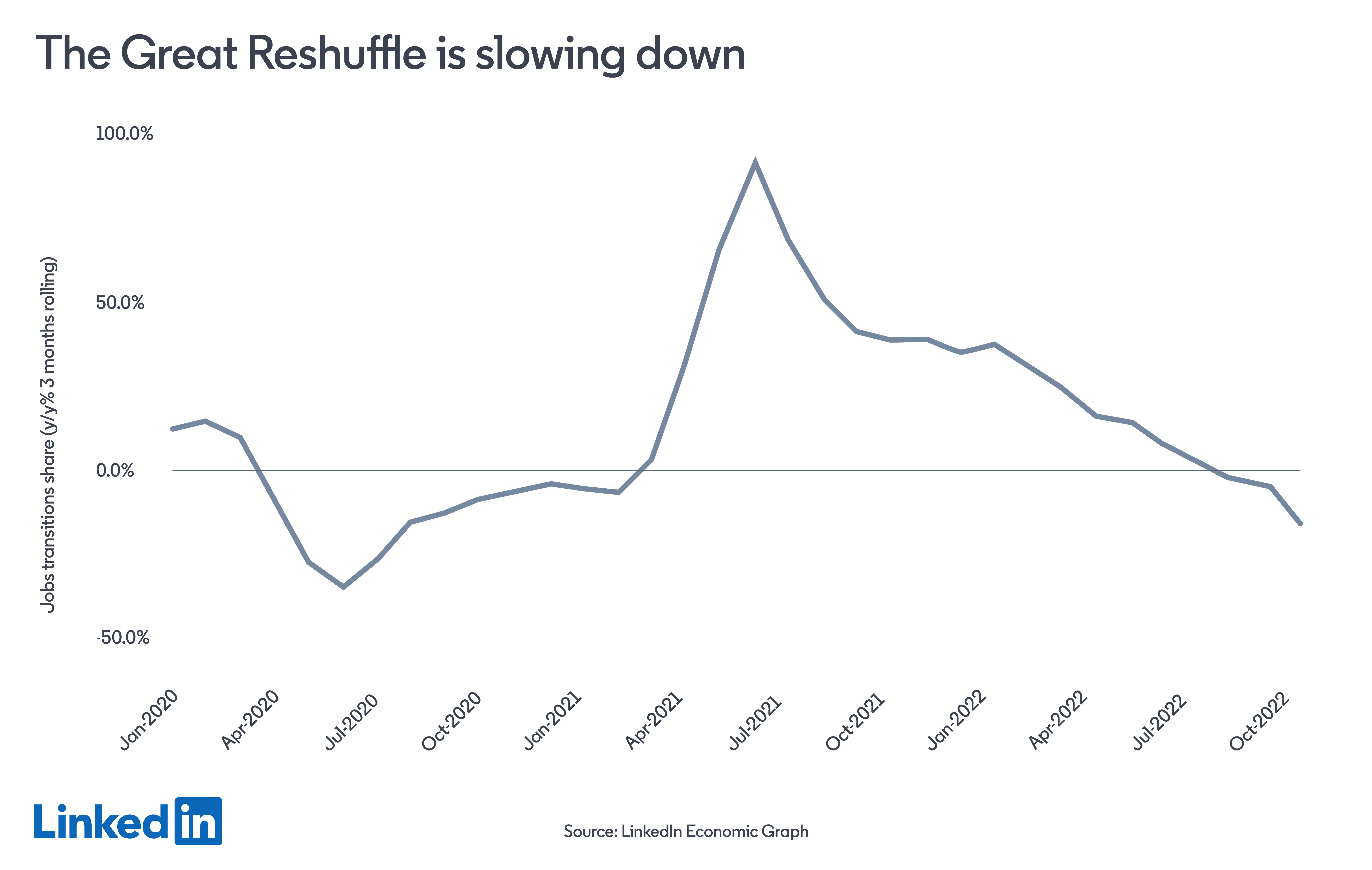
Labor markets remain resilient despite negative headlines
Subscribe to these updates here.
This month's top takeaways:
Labor markets remain tight across developed markets, but we expect them to soften in the coming months as economic activity weakens.
Hiring continued to gradually decline in October, even as demand for workers remained elevated with job postings well above their pre-pandemic baseline.
There are two labor markets in the U.S. nowadays. There’s the market for remote work, and the market for onsite jobs. The former is cooling down quickly, and the latter is still tight.
Despite recession fears, labor markets across the globe remain tight
Job postings on LinkedIn remain at historically high levels and the ratio of active job openings to active applicants, LinkedIn’s measure of labor market tightness, remains elevated in many countries despite broader economic uncertainty. Additionally, in almost all countries, the average number of applications sent per applicant has increased in October 2022 compared to last year–suggesting that overall search effort by job seekers has been intensifying.

Hiring is leveling off after the historic highs we saw in 2021, but remains on average higher than in 2020 and 2019. Hiring across the EMEA region as a whole was down (-11.6% on average), slowing from September (-8.7% on average), but remains stronger in October this year (by 4.9% on average) compared to October 2020 and (2.5%) compared to October 2019. Hiring was also down in the U.S. as companies have started to tighten their belts and take a more judicious approach to recruiting. While some employers are resorting to hiring freezes, many are carefully considering which hires are necessary and they’re increasingly looking inside the organization to fill open roles.

U.S. labor market overview
The U.S. labor market remains strong despite ongoing global uncertainty and rising interest rates. Since January 2021, the economy has added jobs every month, with latest data pointing to nearly one job opening for every active applicant on LinkedIn. The labor market is, however, showing some signs of cooling, particularly as demand for workers slows down. As the Federal Reserve barrels ahead with its efforts to tame inflation, there is a risk that this normalization would turn into a more sustained slowdown.
While U.S. job growth has slowed, the leveling out has been relatively moderate
Job openings crept down in October from their May 2022 peak, reflecting some cooling in employer demand for workers and ongoing economic uncertainty. However, opportunities remain notably higher than their pre-pandemic level. As of November 1, 2022, job openings on LinkedIn were still more than double the pre-pandemic level. The recent slowdown continues to be driven by job sectors in which remote work is more frequently advertised. Our data show that the share of remote job listings has been especially robust in four broad economic sectors. Technology, information and media top the rankings, at 42%. Professional services (28%) is next, followed by Education (25%), and administrative and support services (24%). In each of these sectors, more than 20% of paid job listings involve remote work.

The cooling down in the job market aligns with reports of a widespread slowdown in hiring across many industries
Hiring slowed down in October 2022, declining 0.5% from September, and 10.6% from October 2021. While there is no sign yet of a big decrease similar to the one we saw in the Spring, hiring continues to creep down below pre-COVID hiring levels (February 2020), which now sits at 7.6% lower. Similar to the previous month, Technology, Real Estate and Retail continue to see hiring declines. On the other hand, five out of the twenty industries that we track saw an increase in hiring, with notable month-to-month gains in Farming, Ranching, Forestry (8% higher); Government Administration (3.5% higher), and Consumer Services (2% higher). Across the cities we track regularly, six metro areas experienced month-over-month increases in October: Atlanta, Dallas, Denver, Detroit, Nashville, and New York City. This is an increase from last month where no metros saw hiring gains. Three metro areas -- Nashville, Miami, Houston -- had hiring above pre-COVID levels, up from two last month.

…but despite ongoing economic uncertainty and rising interest rates, the U.S. labor market remains strong
While standard metrics such as the unemployment rate and the job openings-to-unemployment rate ratio suggest that the labor market is exceptionally tight, these conventional measures may not be telling the whole story. In particular, the unemployed may be a weak proxy for the pool of available workforce. It has been posited that, to the extent that firms have been able to meet their needs by hiring from a more expansive pool than just the unemployed–including those with jobs–then the labor market may be less tight than what is implied by the standard measures. Indeed, we find this to be the case.
LinkedIn’s ratio of active job openings to active applicants provides a more comprehensive view of the degree of labor market tightness. Our measure suggests that on the last day of October, there was roughly one job opening for every job seeker who is actively applying for jobs. A ratio greater than one means there are more job openings than people looking to work. For instance, in the first few months of 2020, this ratio averaged around 0.5, suggesting that there were nearly two active applicants for every job opening on LinkedIn.

Conditions for remote work appear to be cooling down much faster than for non-remote jobs
LinkedIn’s measure of labor market tightness suggests that there are two labor markets today. There’s the market for people who have been only seeking remote work, and the market for people who have been only applying for on-site jobs. The former is cooling down very quickly, and the latter appears to be exceptionally tight. The figures below show how conditions in the labor market differ vastly for remote work compared to what is happening in the market for onsite work.


The cooling in the remote labor market is driven by both a slowdown in remote openings and an uptick in the number of people who want more of it
LinkedIn’s data suggest that more people want to work from home but remote job postings are declining. The percentage of remote-job listings on LinkedIn reached an all-time high of 20% in February, but fell to 14% in October. That is, only 1 out of 7 job postings in the US offered remote work in October 2022. While this number has been slowing down, it is still more than triple the rate in October 2020 and up nearly 10-fold from remote work’s meager 2.8% share in January 2020, before the Covid-19 pandemic began.
Despite the drop in remote working jobs, these postings are still receiving over half of the total applications. Our data show that the percentage of applications that went to remote jobs reached just over 50% in October (slightly lower than its peak of 53% in July 2022). Hence, workers continue to prize flexibility and work-life balance even as the economic outlook darkens.

Despite some cooling, it is still a job seekers’ market
Workers are still confident in the tight labor market and expect to land jobs elsewhere, even amid economic uncertainty. We are seeing many new hires taking employers for a test-drive–and walking away. LinkedIn’s short tenure rate, which measures the fraction of positions that were held for less than a year, has increased across industries over the recent months. Some industries are seeing a more prevalent rise in ‘quick quitting’ than others. The short-tenure rate in the entertainment industry, for example, rose 12.1% year-on-year in October, followed by tech and media (10.8%) and administrative and support services (9.5%).

But the power balance is likely to start leveling out in the coming months
Employed workers continue to move between jobs although at a lower rate than the previous year. The U.S. job transitions rate declined -16% y/y in October 2022 compared to high rates of 38% y/y last October 2021, suggesting that workers are starting to hunker down as economic uncertainty and inflation persist.
Relatedly, workers’ interest in getting new jobs is driving more focus on promoting internal candidates, which LinkedIn’s data show increases retention. According to our data at LinkedIn, workers who made an internal move have a 75% chance of sticking around after two years. That falls to 56% for those who haven't.

…as competition and intensity of job search starts to notably increase
Job seekers in the U.S. are returning to the labor market and are searching more intensely. As job openings on LinkedIn eased from their May peak, we are seeing a lot more workers are returning back to the labor market. The number of active job applicants on LinkedIn rose slightly in October from its level in the previous month (+0.8%) and is 19% higher than October 2021. Additionally, the intensity of job search among job seekers, measured by the number of applications per applicant, is witnessing a notable increase from last year. The ratio of applications sent per applicant was 22 percent higher in October 2022 compared to the same month last year.

The Outlook for the U.S. Labor Market Going Forward
Despite ongoing global uncertainty, the data for October reflect the ongoing strengths in the U.S. labor market with still plentiful job openings, modest hiring, and workers still quitting to seek out better pay and benefits. Such a degree of job creation coupled with a relatively low unemployment rate is an outcome that the Federal Reserve is seeking as it battles decades-high inflation.
In parallel, a tight labor market coupled with limited recovery in labor force participation and an aging workforce all suggest that hiring skilled talent will remain a challenge for employers in the near term. However, the Fed’s rapid monetary policy tightening is expected to have a more visibly negative impact on the labor market by 2023.
As dynamics across the labor market shift, companies are recognizing that having the right people with the right skills in the right roles is what will set them up to smoothly navigate more turbulent times–and are shifting towards a skills-first approach to achieve that.
+++++++++++++++++++++++++++++++++++++++++++++++++++++++++++++++++++++++++++++
This article was updated on November 2, 2023.
Definitions
Hiring Rate. The LinkedIn Hiring Rate (LHR) is the number of LinkedIn members who added a new employer to their profile in the same month the new job began, divided by the total number of LinkedIn members in that country. By only analyzing the timeliest data, we can make month-to-month comparisons and account for any potential lags in members updating their profiles. This number is indexed to the average month in 2016; for example, an index of 1.05 indicates a hiring rate that is 5% higher than the average month in 2016.
Open Job Postings. Open premium job postings (paid job postings by employers) on LinkedIn are counted each day. A 14-day moving average of open job postings is calculated to reduce noise from the daily data. The 14-day moving averages of open job postings are then indexed to February 12th of that year.
Remote Jobs. A “remote job” is defined as one where either the job poster explicitly labeled it as “remote” or if the job contained keywords like “work from home” in the listing. The share of remote jobs is calculated in proportion to all paid job postings. LinkedIn analyzed over 1.5 million paid remote job postings in the United States posted since January 2020.
Short Tenure Rate. The YoY change of the “short tenure rate,” is defined as the fraction of positions that were held for less than a year.
Job Transitions. Job transitions are calculated from updates to LinkedIn profiles when a new job at a different company is created after a previous job has ended. This is divided by LinkedIn membership to account for membership growth. This share is compared to the equivalent time in 2019, before COVID, to benchmark the job transition rate against a more “typical” economic year. Student jobs, side jobs, and internships are not included. Jobs must be created on LinkedIn in the same month of the job start date to account for lag in how members update their profile.
Labor Market Tightness. Tightness is measured as the number of active job openings on LinkedIn divided by the total number of applicants in a given month. We measure active job openings as the stock of open job positions on the last business day of the month multiplied by an index of recruiting intensity. The idea behind recruiting intensity is to measure how actively employers are looking to fill vacant jobs. To quantify that, we follow the method developed by Steven J. Davis, R. Jason Faberman and John Haltiwanger (DFH)—the key idea is that a slack labor market makes it easier for employers to hire in general, so less recruiting effort is required to achieve the same hiring rate. To measure active applicants, we include all individuals applying from within the U.S., and who submit at least one application to a U.S.-based job posting.
